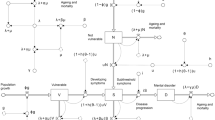Abstract
According to a recent report (National Academy Press, 1994), nearly one third of American adults will suffer from a diagnosable mental disorder during their lifetime and, even more significant, nearly 20% will have a disorder at any given time (p. xi). Unfortunately, there is an insufficient pool of well-trained prevention researchers who study the causes and prevention of mental disorders.
Access this chapter
Tax calculation will be finalised at checkout
Purchases are for personal use only
Preview
Unable to display preview. Download preview PDF.
Similar content being viewed by others
References
Blum, H. (1994). The pre-service teachers educational training in classroom discipline: a national survey of teacher education programs. (Doctoral dissertation, Temple University Graduate Board). Dissertation abstracts international (UMI Dissertation Service. No. 9434650).
Ensminger, M., Kellam, S., & Rubin, B. (1983). School and family origins of delinquency: comparison by sex. In K. Van Duse, S. Mednick, (Eds.), Prospective Studies of Crime and Delinquency. Boston: Kluwer-Nijhof, pp. 73–97.
Institute of Medicine. (1994). In P.J. Mrazek & R.J. Haggerty (Eds), Reducing Risks for Metal Disorders: Frontiers for Preventive Intervention Research. Washington, DC: National Academy Press.
Jones, V. (1996). Classroom management. In J.P. Sikula, T.J. Buttery, & E. Guyton (Eds.), Handbook of Research on Teacher Education. New York: Simon and Schuster Macmillan.
Kellam, S. (1990). Developmental epidemiologic framework for family research on depression and aggression. In G.R. Patterson (Ed.), Depression and Aggression in Family Interaction. Englewood Cliffs, NJ: Erlbaum pp. 11–48.
Kellam, S., Brown, C., Rubin, B., & Ensminger, M. (1983). Paths leading to teenage psychiatric symptoms and substance use: developmental epidemiological studies in Woodlawn. In S. Guze, F. Earls & J. Barrett (Eds.), Childhood Psychopathology and Development. New York: Raven Press, pp. 17–55.
Kellam, S., Ling, X., Merisca, R., Brown, C, & Lalongo, N. (1998). The effect of level of aggression in the first-grade classroom on the course and malleability of aggressive behavior into middle school. Development and Psychopathology, 10, 165–185.
Kellam, S. Rebok, G. 1992. Building developmental and etiological theory through epidemiologically based preventive intervention trials. In J. McCord, & R.E. Tremblay (Eds.), Preventing Anti-Social Behavior: Interventions from Birth through Adolescence. New York: Guilford Press, pp. 162–195.
Kellam, S. & Van Horn, Y. (1997). Life course development, community epidemiology, and preventive trials: A scientific structure for prevention research. American Journal of Community Psychology, 25(2), 177–188.
Kellam, S., Werthamer-Larsson, L., Dolan, F., Brown, C., Mayer, L., Rebok, G., Anthony, A., Laudoff, J., & Edelsohn, G. (1991). Developmental epidemiologically based preventive trials: baseline modeling of early target behaviors and depressive symptoms. American Journal of Community Psychology, 19(4), pp.563–584.
National Commission on Teaching and America’s Future. (1997). Doing What Matters Most: Investing In QualityTeaching. New York: NCTAE
National Council of Accreditation of Teacher Education. (1997). Standards and Policies for the Accreditation ofProfessional Education Units. Washington, DC: NCATE.
National Council of Accreditation of Teacher Education. (1996). Teacher Preparation: A Guide to Colleges andUniversities. Washington, DC: NCATE.
National Institutes of Health, National Institute of Mental Health. (1998). Priorities for Prevention Research at NIMH: A Report by the National Advisory Mental Health Council Workgroup on Mental DisordersPrevention Research. Rockville, MD. Author.
National Institute of Mental Health. (1995). A Plan for Prevention Research for the National Institute of MentalHealth: A Report to the National Advisory Mental Health Council.
Editor information
Editors and Affiliations
Rights and permissions
Copyright information
© 2002 Springer Science+Business Media New York
About this chapter
Cite this chapter
Rhodes, W.A., Murray, R., Greer-Chase, M. (2002). Prevention Science. In: Chunn, J.C. (eds) The Health Behavioral Change Imperative. Springer, Boston, MA. https://doi.org/10.1007/978-1-4615-0731-4_4
Download citation
DOI: https://doi.org/10.1007/978-1-4615-0731-4_4
Publisher Name: Springer, Boston, MA
Print ISBN: 978-1-4613-5214-3
Online ISBN: 978-1-4615-0731-4
eBook Packages: Springer Book Archive




